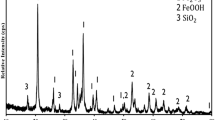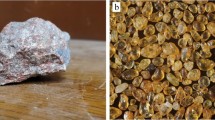Ongoing development of manganese ore deposits in various countries and their treatment in special ferroalloys furnaces leads to continued environmental pollution by manganese compounds. At the same time, waste generated by companies is a valuable raw material that can be used to create marketable products. What is equally important is that low-cost and highly profitable production will contribute to the economic progress of regions and countries as a whole. That is of particular importance since toxic waste increases from 4 to 5 million tons each year. Several methods and technologies developed over the past decade may be proposed for the development, field demonstration, and implementation of the decontamination and use of metallic waste and contaminated soils. Among these is chemical-metallurgical enrichment of manganese, bacterial and chemo-bacterial leaching of manganese and arsenic, treatment of soils with ferrous and ferric sulfates and lime, phytoremediation, solidification, and stabilization of soils. Traditional industrial waste technologies are associated with significant energy costs, long process times, and the need for complex and expensive equipment. Waste generated in industrial operations is a valuable raw material and can be used to produce new marketable products. The study on the effectiveness of self-propagating high-temperature synthesis (SHS) methods, characterized by the simplicity of required equipment, the purity of the final product, and the high processing speed, is of high scientific and practical interest. The work presents technological aspects of obtaining ligature by the SHS method from finely dispersed particles of manganese ore wastes and dust obtained in silicomanganese production. Features and the main parameters to control the phase composition of synthesis products have been experimentally established, as well as the effect of overloads on cast ligature formation patterns and structure formation mechanisms. It has been demonstrated that valuable products can be obtained from finely dispersed waste through SHS metallurgy. In order to reduce the cost and increase the competitiveness of the manganese-containing ligatures obtained, a wide range of studies were conducted with various initial components. The economic feasibility of producing multi-component ligatures from the waste of manganese production has been established and justified. The proposed scientific approach will enable turning tens of millions of tons of ore and ferroalloy production wastes into industrial circulation globally and releasing millions of hectares of land littered with this waste to rehabilitate it.


Similar content being viewed by others
References
Y.V. Baimakov and A.I. Zhurin, Electrolysis in Hydrometallurgy, Metallurgizdat, Moscow (1963), p. 616.
G.M. Woldman, Fundamentals of Extraction and Ion Exchange Processes Hydrometallurgy, Metallurgy, Moscow (1982), p. 376.
N.A. Kostin, V.S. Kublanovsky, and A.V. Zabludovsky, Pulse Electrolysis, Naukova Dumka, Kyiv (1989). [electronic resource.] – Access mode: http://mirknig.com/knigi/nauka_ucheba/1181445685-impulsnyy-elektroliz.html.
A.G. Merzhanov, I.P. Borovinskaya, and V.M. Shkiro, “The phenomenon of wave localization of auto-braking solid-phase reactions,” State Register Discoveries, No. 287 (1984).
V.G. Zakharov, Z.G. Aslamazashvili, G.S. Oniashvili, G.F. Tavadze, A.A. Chirakadze, G.V. Mikaberidze, and G.G. Urushadze, “Scientific and applied experiments on obtaining new materials and products from them by the method of SHS-metallurgy,” II Int. Conf. ‘Modern Technologies and Methods of Inorganic Materials Science’ (April 20–24, 2015, Tbilisi, Georgia), Tbilisi (2015).
V.I. Yukhvid, A.R. Kachin, G.V. Zakharov, “Centrifugal SHS Surfacing of the refractory jnorganic materials,” Int. J. Sejf-Propogating High-Temperature Synthesis, 3, No. 4, 321–332 (1994).
G. Jandieri, D. Sakhvadze, G. Zakharov, and R. Kharati, “Development and research of SHS-technology for obtaining special multicomponent ligatures from ferroalloy production waste. Technologies of the XXI century,” Metall. Mechan. Eng., No. 3 (2019).
G. Oniashvili, G. Tavadze, G. Zakharov, and Z. Aslamazashvili, Self-Propagating High-Temperature Synthesis of Ferroalloys, LAP Lambert Academic Publishing (2018), p. 80.
M. Wireman, A. Chirakadze, I. Khomeriki, Z. Buachidze, D. Khutsishvili, D. Bibiluri, and L. Sharikadze, Z. Sikmashvili, “Development of novel environmental methods facilitating the sustainable development and byproduct synergy in Georgia and South Caucasian Countries: Further progress,” in: Int. Conf. Related to the 90th Anniversary of the Foundation of Georgian Technical University: Proceedings, Tbilisi (2011), pp. 390–400.
A. Chirakadze, Z. Buachidze, A. Gigineishvili, L. Gurchumelia, G. Kervalishvili, M. Wireman, T. Chichua, V. Gvakharia, I. Basghadze, and I. Geleishvil, “Combined processing of waste organic polymers and manganese bearing waste/low-grade ores into fuels and low-carbon manganese alloys. Complex processing of manganese bearing waste and low-grade ores by autoclaving method,” in: Proceedings of 13th Int. Conf. on Clean Energy (June 8–12, Istanbul, Turkey), Istanbul (2014), pp. 1425–1436.
Author information
Authors and Affiliations
Corresponding author
Additional information
G.F. Tavadze and G.Sh. Oniashvili are deceased
Published in Poroshkova Metallurgiya, Vol. 60, Nos. 7–8 (540), pp. 154–160, 2021.
Rights and permissions
About this article
Cite this article
Zakharov, G., Tavadze, G., Oniashvili, G. et al. Obtaining of Ligatures from Manganese Production Wastes by Self-Propagating High-Temperature Synthesis. Powder Metall Met Ceram 60, 513–518 (2021). https://doi.org/10.1007/s11106-021-00263-9
Received:
Published:
Issue Date:
DOI: https://doi.org/10.1007/s11106-021-00263-9




